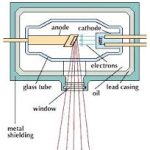How Does It Work (6)
During March we will be using the theme of “how things work” to increase our vocabulary.
This week’s English lesson :
X-Rays
SECTION ONE (How it works)
X-rays are a form of electromagnetic radiation with wavelengths shorter than ultraviolet light, allowing them to penetrate solid matter and provide detailed images of the internal structures of objects, most notably human bodies. The discovery of X-rays dates back to November 8, 1895, when German physicist Wilhelm Conrad Röntgen accidentally observed them while experimenting with cathode rays in his laboratory. He noticed that a fluorescent screen in his lab began to glow even though it was not in the direct path of the cathode rays, leading him to hypothesize the existence of a new form of radiation. Röntgen named the new rays “X-rays,” with “X” denoting an unknown quantity. His groundbreaking work earned him the first Nobel Prize in Physics in 1901, and he is credited with the development of radiology as a critical tool in medicine. The fundamental operation of X-ray imaging involves directing X-rays towards a patient, where they interact with the body’s tissues, being absorbed by denser materials like bones while passing through softer tissues. This difference in absorption is captured on film or a digital detector, producing a diagnostic image that assists healthcare professionals in identifying fractures, tumors, and other medical conditions. Over the years, advancements in X-ray technology, such as computed tomography (CT) scans, have further enhanced the capability of X-rays in medical diagnostics and treatment planning.
VOCABULARY: After reading the text discuss the words “body’s tissues” and name some of the body’s soft tissues in English.
GRAMMAR: Go back through the text and say all of the verbs in the text.
DIAGRAM
1. 
SECTION TWO (Vocabulary)
1. **Radiation**: A form of energy that travels through space and matter, including X-rays which are part of the electromagnetic spectrum and can penetrate tissues to create images.
2. **Imaging**: The process of creating visual representations of the interior of a body for clinical analysis, with X-rays being one of the primary modalities used in medical imaging.
3. **Penetration**: Refers to the ability of X-rays to pass through certain materials, such as human tissue, allowing them to reveal internal structures based on the varying levels of absorption.
4. **Fluorescence**: The emission of light by a substance that has absorbed light or other electromagnetic radiation; in the context of X-rays, it can refer to the glow observed in materials exposed to X-ray radiation.
5. **Detector**: A device that captures X-rays after they pass through the body; it can either be a film or digital sensor used to create the image based on how X-rays were absorbed differently by various tissues.
6. **Dosimetry**: The measurement and assessment of the dose of radiation exposure a patient receives during an X-ray procedure, crucial for ensuring patient safety and minimizing risks associated with radiation.
7. **Contrast media**: Substances used to enhance the visibility of certain areas within the body during X-ray examinations; these materials, such as barium or iodine, improve the differentiation between different tissues.
8. **Radiologist**: A medical doctor specialized in interpreting medical images, including X-rays, and diagnosing conditions based on these images; they play a crucial role in patient care.
9. **Fluoroscopy**: A real-time imaging technique that uses X-rays to obtain continuous images of the internal structures of a patient, often utilized for guiding minimally invasive procedures.
10. **Computed Tomography (CT scan)**: An advanced imaging technique that combines X-ray technology with computer processing to create cross-sectional images (slices) of the body, allowing for detailed examination of internal organs and structures.
SECTION FOUR: Watch the 6 minute video and then answer the four questions below.
QUESTIONS:
- What is an ailment?
- What is a cathode tube and where else could you find cathode tubes?
- What are bones made of?
- What three elements are the bodies soft tissues made of?
